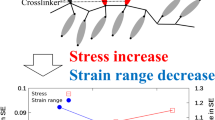Abstract.
We study the mechanical anisotropy of a series of uniaxial side chain nematic elastomers prepared with the same chemical composition but with different preparation protocols. For all the compounds, the experiments performed as a function of temperature show no discontinuity in both G' // and G' ⊥ (the labels // and ⊥ stand for the director parallel, respectively perpendicular to the shear displacement) around the nematic-isotropic (N-I) phase transition temperature determined by DSC. They also all show a small decrease in G' // starting at temperatures well above this temperature (from ∼ 4° C to ∼ 20° C depending on the compound studied) and leading to a small hydrodynamic value of the G' ⊥/G' // ratio. The measurements taken as a function of frequency show that the second plateau in G' // and the associated dip in G //” expected from dynamic semi-soft elasticity are not observed. These results can be described by the de Gennes model, which predicts small elastic anisotropy in the hydrodynamic and linear regimes. They correspond to the behavior expected for compounds beyond the mechanical critical point, which is consistent with the NMR and specific heat measurements taken on similar compounds. We also show that a reduction in the cross-linking density does not change the non-soft character of the mechanical response. From the measurements taken as a function of frequency at several temperatures we deduce that the time-temperature superposition method does not apply. From these measurements, we also determine the temperature dependence of the longest relaxation time τE of the network for the situations where the director is either parallel or perpendicular to the shear velocity. Finally, we discuss the influence on the measurements of the mechanical constraint associated with the fact that the samples cannot change their shape around the pseudo phase transition, because of their strong adherence on the sample-bearing glass slides.
Similar content being viewed by others
References
For a recent review article see H.R. Brand, H. Pleiner, P. Martinoty, Soft Matter 2, 182 (2006).
P.G. de Gennes, M. Hébert, R. Kant, Macromol. Symp. 113, 39 (1997).
P.G. de Gennes, in Liquid Crystals of One- and Two-Dimensional Order, edited by W. Helfrich, G. Heppke (Springer, Berlin, 1980) p. 231.
L. Golubovic, T.C. Lubensky, Phys. Rev. Lett. 63, 1082 (1989).
P. Olmsted, J. Phys. II 4, 2215 (1994).
M. Warner, P. Bladon, E.M. Terentjev, J. Phys. II 4, 91 (1994).
M. Warner, E.M. Terentjev, Liquid Crystal Elastomers (Oxford University Press, Oxford, 2003).
T.C. Lubensky, R. Mukhopadhyay, L. Radzihovsky, X. Xing, Phys. Rev. E 66, 011702 (2002)
The superscript $\sim$ indicates that the elastic modulus $C_{44}$ has been renormalized by director fluctuations.
E.M. Terentjev, M. Warner, Eur. Phys. J. E 4, 343 (2001).
S.M. Clarke, A.R. Tajbakhsh, E.M. Terentjev, M. Warner, Phys. Rev. Lett. 86, 4044 (2001).
P. Martinoty, P. Stein, H. Finkelmann, H. Pleiner, H.R. Brand, Eur. Phys. J. E 14, 311 (2004).
S.M. Clarke, A. Hotta, A.R. Tajbakhsh, E.M. Terentjev, Phys. Rev. E 65, 021804 (2002).
A. Hotta, E.M. Terentjev, Eur. Phys. J. E 10, 291 (2003).
E.M. Terentjev, A. Hotta, S.M. Clarke, M. Warner, Phil. Trans. R. Soc. London, Ser. A 361, 653 (2003).
E.M. Terentjev, M. Warner, Eur. Phys. J. E 14, 323 (2004).
P. Martinoty, P. Stein, H. Finkelmann, H. Pleiner, H.R. Brand, Eur. Phys. J. E 14, 329 (2004).
O. Stenull, T.C. Lubensky, Eur. Phys. J. E 14, 333 (2004).
P. Martinoty, P. Stein, H. Finkelmann, H. Pleiner, H.R. Brand, Eur. Phys. J. E 14, 339 (2004).
A. Lebar, Z. Kutnjak, S. Zumer, H. Finkelmann, A. Sanchez-Ferrer, B. Zalar, Phys. Rev. Lett. 94, 197801 (2005).
J. Küpfer, H. Finkelmann, Makromol. Chem. Rapid Commun. 12, 717 (1991).
P. Stein, N. Aßfalg, H. Finkelmann, P. Martinoty, Eur. Phys. J. E 4, 255 (2001).
J.-L. Gallani, L. Hilliou, P. Martinoty, F. Doublet, M. Mauzac, J. Phys. II 6, 443 (1996).
J. Weilepp, P. Stein, N. Aßfalg, H. Finkelmann, P. Martinoty, H.R. Brand, Eur. Phys. Lett. 47, 508 (1999).
J. Weilepp, J.J. Zanna, N. Aßfalg, P. Stein, L. Hilliou, M. Mauzac, H. Finkelmann, H.R. Brand, P. Martinoty, Macromolecules 32, 4566 (1999).
J.J. Zanna, P. Stein, J.D. Marty, M. Mauzac, P. Martinoty, Macromolecules 35, 5459 (2003).
P. Martinoty, L. Hilliou, M. Mauzac, L. Benguigui, D. Collin, Macromolecules 32, 1746 (1999).
D. Collin, P. Martinoty, Physica A 320, 235 (2003).
O. Stenull, T.C. Lubensky, Phys. Rev. E 69, 051801 (2004).
P.G. de Gennes, C. R. Acad. Sci. Sér. B 281, 101 (1975).
S. Disch, C. Schmidt, H. Finkelmann, Macromol. Rapid Commun. 15, 303 (1994).
W. Kaufhold, H. Finkelmann, H.R. Brand, Makromol. Chem. 192, 2555 (1991).
J. Küpfer, H. Finkelmann, Macromol. Chem. Phys. 195, 1353 (1994).
J. Schätzle, W. Kaufhold, H. Finkelmann, Makromol. Chem. 190, 3269 (1989).
M. Warner, J. Mech. Phys. Solids 47, 1355 (1999).
G. Verney, M. Warner, Macromolecules 28, 4303 (1995).
M. Schönstein, W. Stille, G. Strobl, Eur. Phys. J. E 5, 511 (2001).
There was a confusion in reference 12. The samples were not preheated at $T = 120$^C, and placed into the cell also heated at $T = 120$^C, as written in the Section Experimental set-up, lines 21--24, column 2. In fact, the samples were placed into the cell at room temperature. Then, the cell was heated up to 120^C and the measurements taken by decreasing the temperature.
The deviations from the Rouse behavior observed for the parallel and perpendicular geometries are not due to the mechanical constraint associated with the fact that the shape change of the sample cannot occur in the cell, because they are observed by placing a new sample into the cell at each temperature of measurement.
Author information
Authors and Affiliations
Corresponding author
Rights and permissions
About this article
Cite this article
Rogez, D., Francius, G., Finkelmann, H. et al. Shear mechanical anisotropy of side chain liquid-crystal elastomers: Influence of sample preparation. Eur. Phys. J. E 20, 369–378 (2006). https://doi.org/10.1140/epje/i2005-10132-5
Received:
Accepted:
Published:
Issue Date:
DOI: https://doi.org/10.1140/epje/i2005-10132-5




